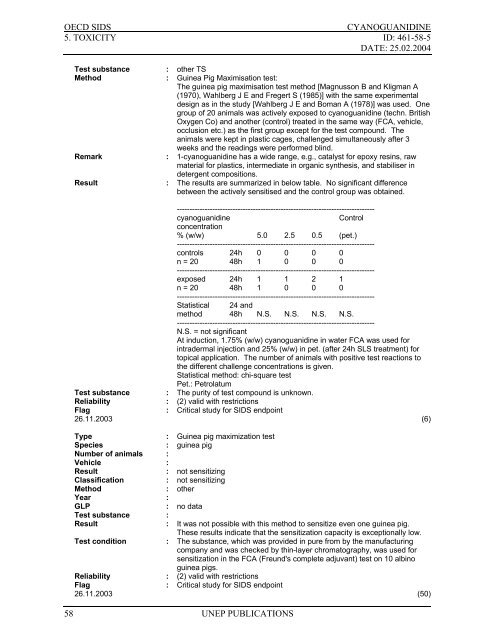Cyanoguanidine CAS N°: 461-58-5
Cyanoguanidine CAS N°: 461-58-5
Cyanoguanidine CAS N°: 461-58-5
You also want an ePaper? Increase the reach of your titles
YUMPU automatically turns print PDFs into web optimized ePapers that Google loves.
OECD SIDS<br />
CYANOGUANIDINE<br />
5. TOXICITY ID: <strong>461</strong>-<strong>58</strong>-5<br />
DATE: 25.02.2004<br />
Test substance : other TS<br />
Method : Guinea Pig Maximisation test:<br />
The guinea pig maximisation test method [Magnusson B and Kligman A<br />
(1970), Wahlberg J E and Fregert S (1985)] with the same experimental<br />
design as in the study [Wahlberg J E and Boman A (1978)] was used. One<br />
group of 20 animals was actively exposed to cyanoguanidine (techn. British<br />
Oxygen Co) and another (control) treated in the same way (FCA, vehicle,<br />
occlusion etc.) as the first group except for the test compound. The<br />
animals were kept in plastic cages, challenged simultaneously after 3<br />
weeks and the readings were performed blind.<br />
Remark : 1-cyanoguanidine has a wide range, e.g., catalyst for epoxy resins, raw<br />
material for plastics, intermediate in organic synthesis, and stabiliser in<br />
detergent compositions.<br />
Result : The results are summarized in below table. No significant difference<br />
between the actively sensitised and the control group was obtained.<br />
------------------------------------------------------------------------------<br />
cyanoguanidine<br />
Control<br />
concentration<br />
% (w/w) 5.0 2.5 0.5 (pet.)<br />
------------------------------------------------------------------------------<br />
controls 24h 0 0 0 0<br />
n = 20 48h 1 0 0 0<br />
------------------------------------------------------------------------------<br />
exposed 24h 1 1 2 1<br />
n = 20 48h 1 0 0 0<br />
------------------------------------------------------------------------------<br />
Statistical 24 and<br />
method 48h N.S. N.S. N.S. N.S.<br />
------------------------------------------------------------------------------<br />
N.S. = not significant<br />
At induction, 1.75% (w/w) cyanoguanidine in water FCA was used for<br />
intradermal injection and 25% (w/w) in pet. (after 24h SLS treatment) for<br />
topical application. The number of animals with positive test reactions to<br />
the different challenge concentrations is given.<br />
Statistical method: chi-square test<br />
Pet.: Petrolatum<br />
Test substance : The purity of test compound is unknown.<br />
Reliability : (2) valid with restrictions<br />
Flag : Critical study for SIDS endpoint<br />
26.11.2003 (6)<br />
Type : Guinea pig maximization test<br />
Species : guinea pig<br />
Number of animals :<br />
Vehicle :<br />
Result : not sensitizing<br />
Classification : not sensitizing<br />
Method : other<br />
Year :<br />
GLP : no data<br />
Test substance :<br />
Result : It was not possible with this method to sensitize even one guinea pig.<br />
These results indicate that the sensitization capacity is exceptionally low.<br />
Test condition : The substance, which was provided in pure from by the manufacturing<br />
company and was checked by thin-layer chromatography, was used for<br />
sensitization in the FCA (Freund's complete adjuvant) test on 10 albino<br />
guinea pigs.<br />
Reliability : (2) valid with restrictions<br />
Flag : Critical study for SIDS endpoint<br />
26.11.2003 (50)<br />
<strong>58</strong><br />
UNEP PUBLICATIONS
















